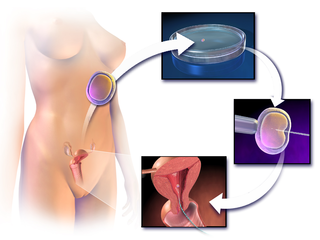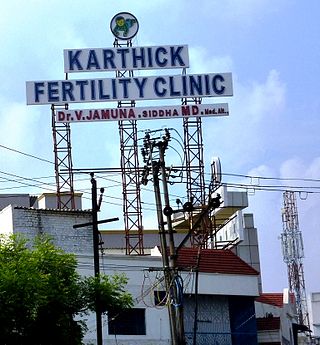
In vitro fertilisation (IVF) is a process of fertilisation where an egg is combined with sperm in vitro. The process involves monitoring and stimulating a patient's ovulatory process, removing an ovum or ova from their ovaries and letting sperm fertilise them in a culture medium in a laboratory. After the fertilised egg (zygote) undergoes embryo culture for 2–6 days, it is transferred by catheter into the uterus, with the intention of establishing a successful pregnancy.

Artificial insemination is the deliberate introduction of sperm into a female's cervix or uterine cavity for the purpose of achieving a pregnancy through in vivo fertilization by means other than sexual intercourse. It is a fertility treatment for humans, and is a common practice in animal breeding, including dairy cattle and pigs.

The Human Fertilisation and Embryology Authority (HFEA) is an executive non-departmental public body of the Department of Health and Social Care in the United Kingdom. It is a statutory body that regulates and inspects all clinics in the United Kingdom providing in vitro fertilisation (IVF), artificial insemination and the storage of human eggs, sperm or embryos. It also regulates human embryo research.
Insemination is the introduction of sperm into a female's reproductive system for the purpose of impregnating, also called fertilizing, the female for sexual reproduction. The sperm is introduced into the uterus of a mammal or the oviduct of an oviparous (egg-laying) animal. In mammals, insemination normally occurs during sexual intercourse or copulation, but insemination can take place in other ways, such as by artificial insemination.
Cecil Byran Jacobson was an American former fertility doctor who used his own sperm to impregnate his patients without informing them.

Assisted reproductive technology (ART) includes medical procedures used primarily to address infertility. This subject involves procedures such as in vitro fertilization (IVF), intracytoplasmic sperm injection (ICSI), cryopreservation of gametes or embryos, and/or the use of fertility medication. When used to address infertility, ART may also be referred to as fertility treatment. ART mainly belongs to the field of reproductive endocrinology and infertility. Some forms of ART may be used with regard to fertile couples for genetic purpose. ART may also be used in surrogacy arrangements, although not all surrogacy arrangements involve ART. The existence of sterility will not always require ART to be the first option to consider, as there are occasions when its cause is a mild disorder that can be solved with more conventional treatments or with behaviors based on promoting health and reproductive habits.
Third-party reproduction or donor-assisted reproduction is any human reproduction in which DNA or gestation is provided by a third party or donor other than the one or two parents who will raise the resulting child. This goes beyond the traditional father–mother model, and the third party's involvement is limited to the reproductive process and does not extend into the raising of the child. Third-party reproduction is used by couples unable to reproduce by traditional means, by same-sex couples, and by men and women without a partner. Where donor gametes are provided by a donor, the donor will be a biological parent of the resulting child, but in third party reproduction, he or she will not be the caring parent.

A sperm bank, semen bank, or cryobank is a facility or enterprise which purchases, stores and sells human semen. The semen is produced and sold by men who are known as sperm donors. The sperm is purchased by or for other persons for the purpose of achieving a pregnancy or pregnancies other than by a sexual partner. Sperm sold by a sperm donor is known as donor sperm.
Egg donation is the process by which a woman donates eggs to enable another woman to conceive as part of an assisted reproduction treatment or for biomedical research. For assisted reproduction purposes, egg donation typically involves in vitro fertilization technology, with the eggs being fertilized in the laboratory; more rarely, unfertilized eggs may be frozen and stored for later use. Egg donation is a third-party reproduction as part of assisted reproductive technology.
Ricardo Hector Asch is an obstetrician, gynecologist, and endocrinologist. He worked with reproductive technology and pioneered gamete intrafallopian transfer (GIFT), as well as working on research linking fertility and marijuana usage, and investigated the use of GnRH analogues with Andrew Schally. In the mid-1990s he was accused of transferring ova harvested from women into other patients without proper consent at the University of California, Irvine's fertility clinic. Asch left the United States one year before a federal indictment was filed. He was tried and acquitted of all charges in Argentina in 2008. In 2011 Mexico denied an extradition request by the United States as it would constitute double jeopardy and no new evidence was brought forth. He is currently living in Mexico City.

Fertility clinics are medical clinics that assist couples, and sometimes individuals, who want to become parents but for medical reasons have been unable to achieve this goal via the natural course. Clinics apply a number of diagnosis tests and sometimes very advanced medical treatments to achieve conceptions and pregnancies.
Sperm donation is the provision by a man of his sperm with the intention that it be used in the artificial insemination or other "fertility treatment" of one or more women who are not his sexual partners in order that they may become pregnant by him. Where pregnancies go to full term, the sperm donor will be the biological father of every baby born from his donations. The man is known as a sperm donor and the sperm he provides is known as "donor sperm" because the intention is that the man will give up all legal rights to any child produced from his sperm, and will not be the legal father. Sperm donation may also be known as "semen donation".
Religious response to assisted reproductive technology deals with the new challenges for traditional social and religious communities raised by modern assisted reproductive technology. Because many religious communities have strong opinions and religious legislation regarding marriage, sex and reproduction, modern fertility technology has forced religions to respond.
Bernard Norman Barwin is a Canadian physician and medical professor. He was appointed to the Order of Canada in 1997, but resigned the award in 2013 after admitting to professional misconduct.
Forced fatherhood or imposed paternity, occurs when a man becomes a father against his will or without his consent. It can include deception by a partner about her ability to get pregnant or use of contraceptives, birth control sabotage, paternity fraud and sexual assaults of males that result in pregnancy.

Bertold Paul Wiesner (1901–1972) was an Austrian-born physiologist noted firstly for coining the term 'Psi' to denote parapsychological phenomena; secondly for his contribution to research into human fertility and the diagnosis of pregnancy; and thirdly for being the biological father to upwards of 600 offspring by anonymously donating sperm used by his wife the obstetrician Mary Barton to perform artificial insemination on women at her private practice in the Harley Street area of London.
Mary Barton was a British obstetrician who, in the 1930s, founded one of the first fertility clinics in England to offer donor insemination. Throughout her career, Barton studied infertility and conception. Her pioneering research and practice were inspired by experience as a medical missionary in India, where she saw the harsh treatment of childless women.

Baby God is an 2020 American documentary film, directed and produced by Hannah Olson, which follows Quincy Fortier, a doctor who used his own sperm to inseminate fertility patients. Heidi Ewing and Rachel Grady were executive producers under their Loki Films banner.

LGBT reproduction refers to lesbian, gay, bisexual, and transgender (LGBT) people having biological children by means of assisted reproductive technology. It is distinct from LGBT parenting, which is a broader cultural phenomenon including LGBT adoption. In recent decades, developmental biologists have been researching and developing techniques to facilitate same-sex reproduction.
Donald Lee Cline is a former American medical doctor of obstetrics and gynecology and convicted felon. Between 1974 and 1987, Cline sired over 90 children without disclosing himself as the sperm donor to his patients. As of May 11, 2022, Cline has been confirmed as the biological father of 94 doctor-conceived offspring.











